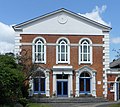- The Shrine of St Edward the Martyr
- The baptismal font
- The iconostasis
| Church of St. Edward the Martyr | |
|---|---|
| St. Edward the Martyr Orthodox Church | |
 The church from the southwest | |
 Church of St. Edward the Martyr | |
| 51°17′58″N0°37′27″W / 51.2995°N 0.6241°W | |
| OS grid reference | SU9591256552 |
| Country | England |
| Language(s) | Greek, Church Slavonic |
| Denomination | True Orthodoxy |
| Previous denomination | |
| Religious order | Saint Edward Brotherhood |
| Website | saintedwardbrotherhood |
| History | |
| Relics held | Edward the Martyr |
| Architecture | |
| Architect(s) | Cyril Tubbs, Arthur Messer |
| Completed | 1909 |
St. Edward the Martyr Orthodox Church is a True Orthodox Church in Brookwood, Surrey, England.
Contents
The monastic Saint Edward Brotherhood was established at Brookwood Cemetery in 1982 to prepare and care for a new church in a fitting grade I landscape [1] in which the relics of Saint Edward the Martyr, the king of England who was murdered in 978 and who was succeeded by force by Ethelred the Unready, were eventually enshrined in 1988. It has two communities:
- A small monastic community who chant the services of the church daily at the shrine.
- 'True Orthodox' Christians who form a mission parish. [2] These Christians supplement the congregation on Sundays and feast days. [3]
St. Edward's is currently under the jurisdiction of the Church of the Genuine Orthodox Christians of Greece (GOC-K), a Greek Old Calendarists True Orthodox Church headed by Archbishop Kallinikos of Athens. [3] It became part of this jurisdiction in 2014 following the merger of the Orthodox Church of Greece (Holy Synod in Resistance), of which it had been a part since leaving the Russian Orthodox Church Outside Russia in 2007, [3] with the GOC-K.








